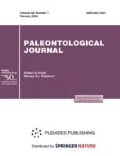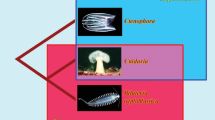Abstract
Architectonics is the study of the division of the animal body into modular structures that are to some extent autonomous in their ontogeny and phylogeny. Thereby it allows key points in the ontogeny of many fossil taxa to be identified. Studying the symmetry of the mutual arrangement of the modular structures of the organism and its evolution, together with the analysis of architectonics, promorphology helps to clarify the evolution of ontogeny in real geological time and thereby brings together paleontology and developmental biology. The application of this approach to echinoderms enables the presence of a torsion process in the ontogeny of all Pelmatozoa and Soluta (among Carpozoa), and the absence of this process in Stylophora, to be demonstrated. The analysis of architectonics and promorphology of Paleozoic tetracorals (Rugosa) revealed the correlation of the oral-aboral and dorsal-ventral axes of their larvae with the oral-aboral and directive axes of the polyp developing from them. This shows that the bilateral symmetry of Anthozoa and possibly of all Cnidaria preceded their radial symmetry.



Similar content being viewed by others
REFERENCES
Arendt, Yu.A., Morskie lilii gipokrinidy (Hypocrinid Sea Lilies), Tr. Paleontol. Inst. Akad. Nauk SSSR, vol. 128, Moscow: Nauka, 1970.
Beklemishev, V.N., Osnovy sravnitel’noi anatomii bespozvonochnykh (Principles of Comparative Anatomy of Invertebrates), vol. 1: Promorfologiya (Promorphology), Moscow: Nauka, 1964.
Beklemishev, V.N., Principles of Comparative Anatomy of Invertebrates, vol. 1: Promorphology, Chicago: Univ. of Chicago Press, 1969.
Belousov, L.V., Osnovy obshchei embriologii (Fundamentals of General Embryology), Moscow: Mosk. Gos. Univ., Nauka, 2005.
Galls, F. and Sinervo, B., Conserved early embryonic stages, Keywords and Concepts in Evolutionary Developmental Biology, Hall, B.K. and Olson W.M., Eds., Cambridge, Mass.; London: Harvard Univ. Press, 2003, pp. 43–52.
Hall, B.K. and Olson, W.M., Introduction: evolutionary developmental mechanisms, Keywords and Concepts in Evolutionary Developmental Biology, Hall, B.K. and Olson W.M., Eds., Cambridge, Mass.; London: Harvard Univ. Press, 2003, pp. XIV–XVI.
Isaeva, V.V., Ozernyuk, N.D., and Rozhnov, S.V., Evidence of evolutionary changes in ontogeny: Paleontological, comparative morphological, and molecular aspects, Izv. Ross. Akad. Nauk, Ser. Biol., 2013, no. 3, pp. 273–283.
Kraus, Y., Aman, A., Technau, U., and Genikhovich, G., Pre-bilaterian origin of the blastoporal axial organizer, Nat. Commn., 2016, vol. 7, no. 11694. Cited 2016. doi 10.1038/ncomms11694
Leonova, T.B., Evolution of Palaeozoic ammonoid sutures, Invert. Zool., 2017, vol. 14, no. 1, pp. 27–31.
Parkhaev, P.Yu., Origin and the early evolution of the phylum Mollusca, Paleontol. J., 2017, vol. 51, no. 6, pp. 663–686. Cited 2017. doi 10.1134/S003103011706003X
Rozhnov, S.V., Morskie lilii nadsemeistva Pisocrinacea (Crinoids of the Superfamily Pisocrinacea), Arendt, Yu.A., Ed., Tr. Paleontol. Inst. Akad. Nauk SSSR, vol. 192, Moscow: Nauka, 1981.
Rozhnov, S.V., Changes in the Early Paleozoic geography as a possible factor of echinoderm higher taxa formation: Delayed larval development to cross the Iapetus Ocean, Palaeogeogr., Palaeoclimatol., Palaeoecol., 2007, vol. 245, nos. 1–2, pp. 306–316.
Rozhnov, S.V., Combinatorial model for the formation of body plans in higher metazoan taxa: paleontological insight, Paleontol. J., 2010, vol. 44, no. 12, pp. 1500–1508.
Rozhnov, S.V., The anteroposterior axis in echinoderms and displacement of the mouth in their phylogeny and ontogeny, Biol. Bull., 2012, vol. 39, no. 2, pp. 162–171.
Rozhnov, S.V., Symmetry of echinoderms: from initial bilaterally-asymmetric metamerism to pentaradiality, Nat. Sci., 2014a, vol. 6, no. 4, pp. 171–183.
Rozhnov, S.V., Bilateral symmetry in ontogeny and regeneration of solitary Rugosa (Cnidaria; Paleozoic), Paleontol. J., 2014b, vol. 48, no. 11, pp. 1183–1193. Cited 2014. doi 10.1134/S0031030114110094
Rozhnov, S.V., Modularity and heterochronies in the evolution of Metazoa: paleontological aspect, Paleontol. J., 2015, vol. 49, no. 14, pp. 1–15.
Rozhnov, S.V., Arms versus brachioles: Morphogenetic basis of similarity and differences in food-gathering appendages of pelmatozoan echinoderms, Paleontol. J., 2016, vol. 50, no. 14, pp. 1598–1609. Cited 2016. doi 10.1134/S0031030116140069
Rozhnov, S.V., Ordovician paracrinoids from the Baltic: Key problems of comparative morphology of pelmatozoan echinoderms, Paleontol. J., 2017a, vol. 51, no. 6, pp. 643–662. Cited 2017. doi 10.1134/S0031030117060065
Rozhnov, S.V., The origin and homology of the jointed appendages of carpoid and pelmatozoan echinoderms, Invert. Zool., 2017b, vol. 14, no. 2, pp. 174–181. Cited 2017. doi 10.15298/invertzool.14.2.12
Rozhnov S.V. Solutans: between torsion and pentaradiality, 16th International Echinoderm Conference, Nagoya, Japan: Program & Abstracts, 2018, p. 105.
Rozhnov, S.V. and Mirantsev, G.V., Structural aberrations in the cup in cladid crinoids from the carboniferous of the Moscow Region, Paleontol. J., 2014, vol. 48, no. 12, pp. 1243–1257. Cited 2014. doi 10.1134/S0031030114120090
Rozhnov, S.V. and Parsley, R.L., A new cornute (Homalozoa: Echinodermata) from the uppermost Middle Cambrian (stage 3, Furongian) from Northern Iran: its systematics and functional morphology, Paleontol. J., 2017, vol. 51, no. 5, pp. 500–550. Cited 2017. doi 10.1134/S0031030117050100
Ruzhencev, V.E., Printsipy sistematiki, sistema i filogeniya paleozoiskikh ammonoidei (Principles of Systematics, the System and Phylogeny of Paleozoic Ammonoids). Orlov, Yu.A., Ed., Tr. Paleontol. Inst. Akad. Nauk SSSR, vol. 83, Moscow: Nauka, 1960.
Sander, K., The evolution of patterning mechanisms: gleanings from insect embryogenesis and spermatogenesis, Development and Evolution, Goodwin, B.C. Holderand, N., and Wylie, C.G., Eds., Cambridge: University Press, 1983, pp. I37–159.
Slack, J.M.W., Phylotype and zootype, Keywords and Concepts in Evolutionary Developmental Biology, Hall, B.K. and Olson, W.M., Eds., Cambridge, Mass., London: Harvard Univ. Press, 2003, pp. 309–318.
Valentine, J.W., On the Origin of Phyla, Chicago: Univ. Chicago Press, 2004.
ACKNOWLEDGMENTS
I am deeply grateful to V.V. Isaeva for comments on the manuscript and G.A. Anikeeva for great help in preparing the figures. This work was supported by a grant from the Russian Foundation for Basic Research, project no. 18-04-01046 A and the fundamental research program of the Presidium of the Russian Academy of Sciences “The Evolution of the Organic World. The Role and Influence of Planetary Processes.” This Paper is a contribution to the International Geoscience Program (IGCP) Project 653–The Onset of the Great Ordovician Biodiversification Event.
Author information
Authors and Affiliations
Corresponding author
Additional information
Translated by S. Nikolaeva
Rights and permissions
About this article
Cite this article
Rozhnov, S.V. Architectonics of Metazoa as the Basis for the Reconstruction of the Ontogeny and Phylogeny of Extinct Taxa. Paleontol. J. 52, 1672–1678 (2018). https://doi.org/10.1134/S0031030118140149
Received:
Published:
Issue Date:
DOI: https://doi.org/10.1134/S0031030118140149




